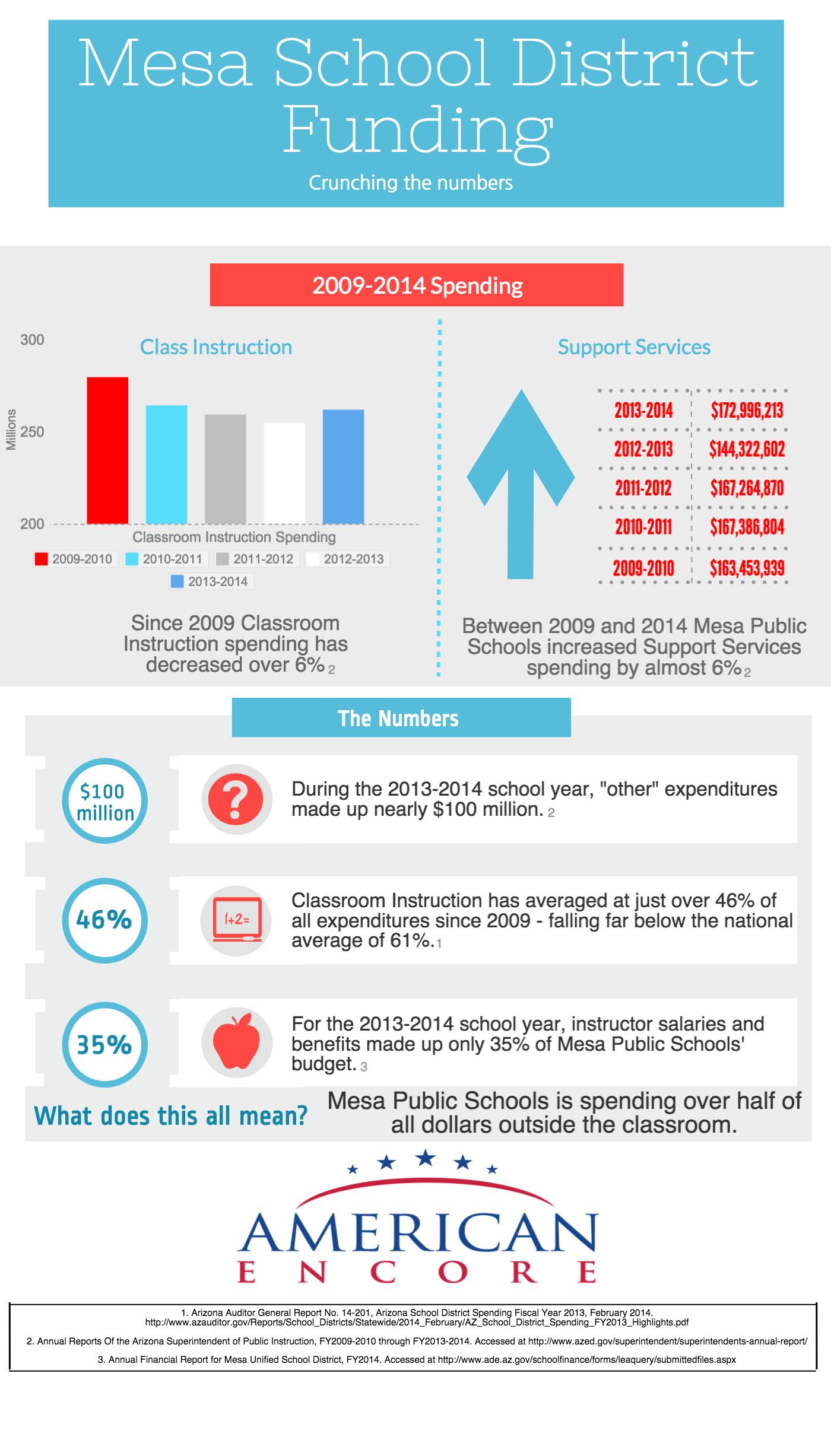Paging Dr. Cowan- Here Are The Real Mesa Schools Budget Numbers

Paging Dr. Cowan- Here Are The Real Mesa Schools Budget Numbers
By: Patrick Hedger-Policy Director, American Encore
Defenders of Mesa School District’s Superintendent Michael Cowan have sought to discredit the revelation that Cowan only spends half of the district’s money in the classroom and only a dismal one-third on compensating the district’s teachers.
Yvonne Wingett Sanchez of the Arizona Republic reported that according to a Cowan spokesperson 56 percent of total operational spending by the district goes into the classroom. The problem with that figure is that it is derived from a total expenditure figure that essentially ignores roughly 62 million dollars that Mesa is spending across other categories.
The 56 percent counter-figure is derived from adding Classroom Instruction spending, defined as, “Regular and Special Education Expenditures related to activities dealing directly with the interaction between teachers and students, excluding classroom supplies,” to Classroom Supplies spending, defined as, “All supply and textbook expenditures related to regular and special education classroom instruction, excluding library books and supplies.” This total figure, roughly $276 million in 2013-2014, is then calculated as a percentage of combined spending on instruction and supplies plus the following:
Administration: “All expenditures pertaining to administering policy for the operation of the district or charter, the business operations of the district or charter, school level administration and all other central support services.”
Support Services - Students: “Expenditures for services such as social work, guidance, health, psychological, speech, audiology and other therapies.”
Other Support Services and Operations: “Expenditures for instructional staff support, media services, and non-instructional services such as food services, plant and maintenance support, transportation and community services operations.”
Together, these five categories totaled $488.5 million in 2013-2014.
276/488.5 = (roughly) 56.5 percent.
The problem with using this isolated figure as a barometer of Cowan’s commitment to the classroom is that it ignores tens of millions of dollars in other types of spending that the school district is engaging in. Further, it ignores long-term trends. Here’s the truth:
In addition to the $488.5 million Mesa School District spent on the five exceptionally vague categories above, an additional $62 million was spent between the categories of Capital Expenditures, defined as, “Capital expenditures for acquisitions by purchase, lease-purchase, lease or longterm lease of capital items that include furniture and equipment, vehicles, land, buildings, and improvements,” and State and Federal Project Expenditures. Another category called Facilities Expenditures has spent an additional $40 million to $45 million each year from 2009-2013. Mysteriously, Mesa reported this figure at $0 for this past year. Regardless, upwards of $40 million flowed to building renewal and renovations, new facilities, improvements to non-school related public property surrounding school facilities, and debt service for almost each year for which data is available. Perhaps Superintendent Cowan has a reason as to how the district didn’t record a single dollar in renovations, property purchases, and debt service in 2013-2014 while spending at least $40 million on these functions each of the four years before. For now, it is safe to remain skeptical.
These additional spending areas raise total district expenditures to $550.6 million for 2013-2014. This is the true total of dollars that flowed out of Mesa School District’s coffers. What is total classroom spending as a percentage of this actual spending figure?
276/550.6 = roughly 50.1 percent. For the three years prior, classroom spending was less than half of total spending, hovering right around 46 and a half percent. Even this 50.1 percent figure should be taken with a grain of salt. Last year, Classroom Supplies spending spiked by nearly 71 percent over the previous year.
Considering these facts, it is more than a valid claim to charge that Superintendent Cowan generally puts the majority of his available resources to use outside of the classroom.
What’s worse is that teachers are paying the price for Cowan’s questionable funding allocation. Since 2009, Supplies spending is up 53.71 percent (most due to last year’s spike as mentioned, otherwise it would be down), Administration spending is nearly flat at -2.9 percent, Student Support Service spending is up 12.37 percent, and Other Support Services spending is up 4.45 percent. Total spending on these categories plus Classroom Instruction has been flat at -.89 percent. Yet Classroom Instruction spending itself is down -6.31 percent. This has lead to teacher and special educator salaries and benefits making up only 35 percent of the corrected total expenditure figure of $550.6 million for the Mesa School District.
For Student Support Service and Other Support Service spending to be increasing and Classroom Instruction spending to be decreasing as total expenditures remain relatively unchanged, the indication must be that money is flowing away from the primary function of the schools and towards ancillary programs.
It’s hard to go much further and track the dollars without engaging in a full-scale audit. Perhaps one should be done. Hundreds of millions of dollars that could have been directed toward classrooms and teachers have instead been spent on extremely vague categories of spending with titles that include “support” and “other.” Total “other” expenditures were nearly $100 million in 2013-2014 alone.
The state of education today, not just in Arizona but also across the country, is shameful. Foreign counterparts are outperforming American students at all levels. There is a dearth of skilled workers in America leading companies to invest elsewhere. In such a scenario, when it is revealed that the Mesa school system, or any school system for that matter, is spending more than half of its available dollars outside of its primary function of education, we would be further failing our students to not take a step back and see if there is another way. How could this possibly be more controversial than doing nothing at all?







